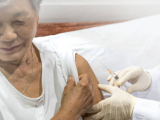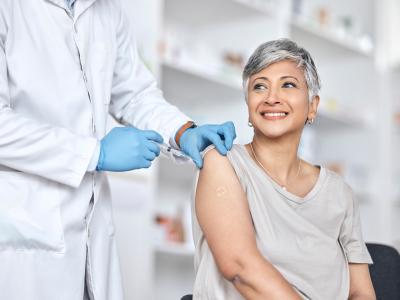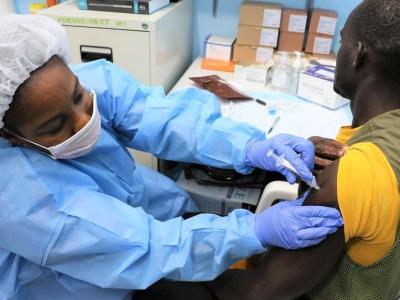Oct 2, 2009 (CIDRAP News) –Many states and some cities will receive their first pandemic H1N1 vaccine doses on Oct 6, and most will distribute the first doses to healthcare workers, though some have included young children in the very first groups to be immunized.
Vaccine distribution plans have been complicated by the fact that the initial doses will be the live-virus nasal-spray vaccine, made by MedImmune, which is not recommended for certain people. That means that some in the highest priority groups—pregnant women and those with underlying medical conditions—won't be able to receive this live attenuated influenza vaccine (LAIV).
States started placing their orders on Sep 30. Some major metropolitan areas also submitted vaccine orders.
Yesterday the Minnesota Department of Health, in announcing its initial vaccine plans, said it expects 28,000 doses of the nasal-spray vaccine in its first shipment. The doses are earmarked for healthcare and emergency medical workers not only because they are at risk of exposure to the virus and could transmit it to patients, but also to minimize work absences.
Sanne Magnan, MD, Minnesota’s health commissioner, said in a press release, "By administering the vaccine first to health care and emergency medical workers, we are helping to ensure that our healthcare system is in good shape to care for Minnesotans who become ill." She added that prioritizing this group is consistent with recommendations from the US Centers for Disease Control and Prevention (CDC).
Virginia's and South Dakota's health departments announced today that their first vaccine shipments will also go to healthcare workers.
Chicago health officials today said emergency personnel such as firefighters are included alongside healthcare workers as the first to receive the city's doses, the Chicago Tribune reported. Today the US Fire Administration, a branch of the Federal Emergency Management Agency (FEMA), recommended that firefighters who provide emergency medical services (EMS) and EMS workers receive the H1N1 vaccine as soon as it is available.
Meanwhile, officials from the Washington State Department of Health said yesterday in a press release that the state's initial 71,000 doses, expected to arrive on Oct 7, will be mainly targeted to healthcare workers, healthy children, and families and caregivers of babies.
The Pennsylvania Department of Health in a Sep 30 press release announced details of its vaccination plan, which involves targeting the first doses of the intranasal vaccine to healthy school children between ages 5 and 9, with a smaller portion for college students at schools where outbreaks have occurred and are continuing.
It predicts that pandemicH1N1 activity will increase in schools. "The department believes it is very important to begin vaccination for children under 10 years of age as early as possible, because they will require two separate doses of pandemic H1N1 vaccine," the department said in its statement.
Officials said they will target the doses to parts of Pennsylvania that are reporting the highest number of cases: the southeast, southwest, and north central areas.
On Sep 30 officials from the Kansas Department of Health and Environment (KDHE) held a press conference to share details about its pandemic H1N1 vaccine distribution plan. The department said it would allocate vaccine to counties based on 2008 population census data of newborns through 24-year-olds.
KDHE officials said the age-based strategy helps better target children and young adults. Once demand for priority groups has been met, Kansas will base vaccine allocations on each county's total population.
The state expects about 16,000 doses in its first allocation. Because of limited supplies during the first weeks, the KDHE is recommending that local health departments target the first doses to healthcare workers who have direct patient contact and healthy children ages 2 through 9.
Like Pennsylvania, Kansas is hoping to get a jump on vaccinating younger children who will need two doses. Jason Eberhart-Phillips, MD, MPH, state health officer and director of health at the KDHE, said in a press release, "The first vaccine doses we receive will be the LAIV, which will be most appropriate for the healthcare workers who have no underlying health conditions and allows for the early administration to healthy 2 through 9 year old children who will require a second dose."
Yesterday Trust for America’s Health (TFAH), a nonprofit, health advocacy group based in Washington, DC, aired concerns about states' ability to conduct mass vaccine distribution in are port on the nation's challenges going into a second wave of pandemic H1N1flu. The group pointed out that a 2008 federal survey revealed 21 states had gaps in their mass vaccination plans.
In its report, TFAH recommended that states and localities refine their plans for rapid vaccine distribution and that the federal government allocate more resources for vaccine delivery.
Unlike the delivery system for the seasonal flu vaccine, government officials are spearheading the delivery of the pandemic vaccine through a central distributor, McKesson. States will be in charge of portioning out their allocations to local health departments, and distribution systems are expected to vary from state to state.
Federal officials have warned the public to expect some early bumps in the vaccine distribution road but have said that by late October and into November there should be enough pandemic vaccine for anyone who wants it.
See also:
Oct 2 Virginia Department of Health press release
http://www.vdh.state.va.us/news/PressReleases/2009/100209H1N1vaccine.htm
Oct 2 South Dakota Department of Health press release
http://www.state.sd.us/news/showDoc.aspx?i=11295
Oct 2 US Fire Administration press release
http://www.usfa.dhs.gov/media/press/2009releases/100209.shtm
Oct 1 Washington State Department of Health press release
http://www.doh.wa.gov/Portals/1/Documents/1500/NewsReleases/2009/09-159H1N1SwineFluVaccineUpdate.pdf
Sep 30 Pennsylvania Department of Health press release
http://www.prnewswire.com/news-releases/department-of-health-details-pandemic-h1n1-vaccine-distribution-plan-for-pa-62872537.html
Sep 30 KDHE press release
http://www.kdheks.gov/news/web_archives/2009/09302009.htm
Oct 1 CIDRAP News story "First H1N1 vaccine doses headed to states, cities"


















